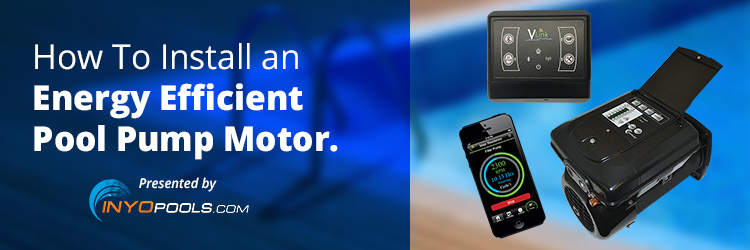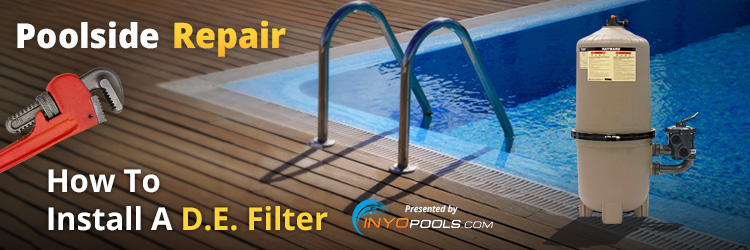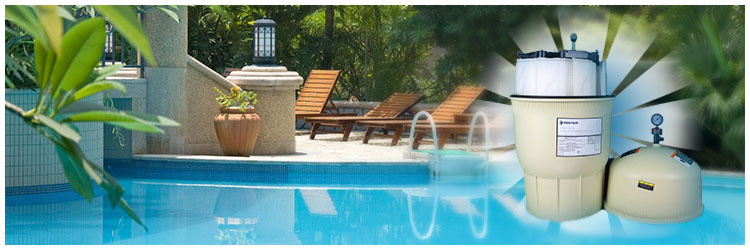Hello and welcome to Poolside Repair. We’re in lovely Orlando, Florida. Matt and Rob are helping out Dennis who wants to install a new Century V-Green with V-Link control on his daughter’s pool.She currently has a single speed motor that’s not cost-efficient. By upgrading to a V-green motor we hope to cut utility cost by at least 50%. The V-Link control and app allows you to track your pump motor’s power consumption, so you can see the savings in real-time.
The Install
Disassembling the pump
We will start with disassembling the old pump to remove the old motor and see what others of the pump we need to replace.
That just pops right off, put this to the side, take the wheel ring. Okay, so the next step would be to remove the impeller, but before you do that, you’ve got to stabilize the shaft, otherwise, it’s going to keep spinning. We’re going to use a 7/16 wrench, slide in here behind the protector. We’re going to stabilize and, basically, you just turn the impeller so that it locks in place like that. And then we’ll spin the impeller off counterclockwise. The seal plate will just pop right off. No critters running out, so that’s good. All right. So we’re going to go ahead and take the bolts out here to get the motor plate.
Again, we’re using a 9/6 inch socket. So we got the bolt out, so we just going to take the motor, play it off, and it’s that simple. All right. So we got the two motors side by side, obviously, this is the old one, is the new, the V-Green. It’s the 1.65. You can see the interface here. The 2.7 has the digital interface.
All the V-Green motors are totally enclosed and fan-cooled, making it last longer than your standard single or dual speed motor.
At this point, we’re going to start to put on some of the old parts back on the new motor, minus the shaft seal. Every time you replace a motor the shaft seal should be replaced along with it. Reusing old shaft seals leads to a leaky seam that will lead water directly to your brand new electric motor. Improper shaft seal installation and its physical effects on the motor is a leading cause voided warranties. So make sure, you find the correct shaft seal or gasket kit.
How to Program The Century V-Green
We’re going to move into programming the motor. The motor comes with a factory preset but, obviously, we want to do our own schedule. The way we’re going to do that is we’re going to press step one. On this side, you can see that it says “duration” over these numbers, and that’s how many hours it’s going to run for. Let’s say we’re going to run it for four hours. You’re going to press step one. Then it’s going to take it over to speed. You can see the RPM readings over there. Let’s have it at 3100. To save that, you would just go to step two, and let’s say step one. We’re going to do the same thing for all of these.
Then once you have step three, the next button push that you do is going to save step three. You don’t have to worry about that. Let’s say you want to do an override.
If you want to, for whatever reason, you want to press override and have it run for, let’s say two hours, and then you’re going to have it run at 3450, which is full-bore, and that will do the full power of the motor. That’s just in case, let’s say, you want to run the cleaner. If you have a suction side cleaner or something like that, it gives you a chance to run the motor, to mess with any of the step; one, two, or three.
We’ve got the VGreen installed. Next thing we’re going to install the century VLink, the wireless motor interface. We’re just going to unbox to take a look at it. Basically, it comes with everything. You’ll need to install it minus the tools. Let’s take a look here. You got your user manual, you got the actual VLink, and then you have all the other cables and the connectors that you’ll need.
Yes. We were looking at the app, and before, it was costing anywhere, depending on the time of year, $50-70 to run the single speed pump per month. The app is already telling us, this is December, but it’s going to be running $10 a month right now. You might be looking at $20 a month in summer, but that’s still a heck of a lot of savings.











Can a VS pump be programmed with its onboard electronics to 2 appropriate speeds that can then be chosen by my old Jandy Aqualink automation box maybe with its Dual Speed Pump Relay Kit?
Can I hook up a hayward booster pump to the auxiliary load?
Yes, a booster pump can be run off the aux hookup.
i need help wiring up a new pump Just purchased a PureLine Prime Variable Speed Pool Pump 1.65 HP to replace a 1 hp single speed motor. when i removed the old pump instead of having a black, red, and green wire. i have two reds and a green. How do i determin what red wire goes on L1 and what one goes on L2 ?
If your old pump was wired for 230-volts then there is no wrong answer. Both of the red wires carry 115 volts, so you just have to put one red wire to each terminal connection, and the green wire to the green ground screw and you are done.
Where would I look if after I’ve installed the v-green 270 and an auxillary load (booster pump) I am not showing any power to the v-motor? the connection at the Line 1 & 2 are hot, but the pump itself doesn’t turn on for me to program the quick start. The documentation that comes with the pump isn’t very complete.
I have 22 years in the aftermarket as a pool tech. I want to hear from ANYBODY why an expensive variable speed pump motor is any better than a standard 2 speed pump. VS pumps want a few hours a day at 3,200 rpm. Then they want longer hours at 1,700 to 1,800 hours a day at low speed.
Guess what? A standard 2 speed motor runs at high speed, 3,450 rpm, low speed runs at 1,725 rpms. Kinda about the same, right?
This whole variable speed crap is nothing but smoke and mirrors. The two speed motors (which have been on the market for decades) can be run in ANY control system. All control systems have 2 speed relays available, and 2 speed pumps will even run with Intermatic mechanical controls.
As a bonus, there are no user unfriendly menus to deal with. As another bonus, you don’t have an electronic computer sitting on top of your pump 24/7/365.
I’m all for innovation in pool technology, but there is NO improvement here, the stuff just costs a lot more and is more prone to failure, while confusing the customer the whole way. Don’t get sold. Talk to someone who works on this stuff, not to the people trying to sell you stuff.
In your 22 years of experience, I would hope you would have come across a pump curve, or possibly read about the law of affinity that governs electricity usage on motors. Because I am not sure where you are getting your RPM numbers but they seem to be wholeshot generalizations. A variable speed motor’s settings are best described as a “tuning process” after the pump is installed. No manufacturer I have heard has stated solidly that a pump would always be set at 3200 RPMs for X period and 1725 for Y period of time. Because different pool have different feet of head, and varying filter sizes. This obviously means that a system is restricted by what type of flow a pump can put through it. 3200 RPMs on Pool ‘A’ may be great while on Pool ‘B’ it is akin to turning on a firehose, harming the filter and doing who knows what else.
With a dual speed, you are stuck with only two speeds, Hi and Lo. So essentially it is full afterburners or a stroll in the park. The variable speed allow you to find the sweet spot between flow and electricity usage.
Besides RPMs you have amp usage, which has this thing called the Law of Affinity that comes into play.
For example: Amp usage and RPMs are not locked together, a dual speed pump running at 3450 may use 15 amps. But the same dual speed pump running at 1725 RPMs only uses 3 amps. The amps drop significantly more than the RPMs, allowing for saving when running on the low speed for long periods rather than on high for short periods.
If I did this to a Pentair Whisperflo, I wouldn’t need to change the impeller? I thought impellers were optimized to run at a particular RPM.
Mike, thanks for sharing.
BTW, I plan to replace a Jandy JHP2.0 motor in the near future.
Good video. Might consider it when mine goes out. I would have liked to have heard the volume difference between the single speed and the new 2 speed running at both levels. Thanks.
We installed a variable speed. Because flowrates vary so much between pump models and RPM range for variable speed motors it is hard to cover that to cover a wide range of pool conditions.
If you are interested in dual speed’s flowrate, you can view its pump curve on the manufacturer’s website. Of course, you will need to calculate your feet of the head so you can find the expected flow rate.
How do you choose the right high-efficiency pool pump replacement motor that’s strong enough to pump water to solar panels on a two story roof.
If you plan to go with a V-Green Variable Speed, it is simple because there are only two options; if your pump’s motor’s total hp is 1.65 or less then you go with the V-Green 1.65, any motors with motors with a 2.7 total hp can use the V-Green 2.7.
And as a reminder, the way you get the total HP of a motor is by multiplying the listed HP by the Service Factor (SF) on the motor label.
For Example, a B854 1.5 HP motor: 1.5 HP times the 1.1 Service Factor equals 1.65 total HP. That means you would need the ECM16SQU
i need my pool pump install
Did you have a question, or is that just kind of a statement?